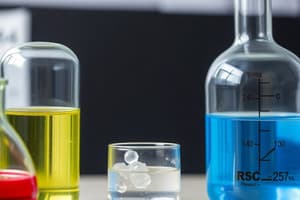Podcast
Questions and Answers
What is a base?
What is a base?
- A material that has no effect on litmus in an aqueous solution
- A material that reacts with an acid to produce just water and salt (correct)
- A material that is commonly found in household cleansers used to remove oil from windows and floors
- A material that tastes sour in water and turns blue litmus red
What is the characteristic of an acid?
What is the characteristic of an acid?
- Tastes sour in water and turns blue litmus red (correct)
- Is commonly found in household cleansers
- Has no effect on litmus in an aqueous solution
- Produces just water and salt when reacting with a base
What happens when an acid reacts with a base?
What happens when an acid reacts with a base?
- It has no effect on litmus in an aqueous solution
- It turns red litmus blue
- It produces a salt (correct)
- It produces just water
What is the characteristic of a salt in an aqueous solution?
What is the characteristic of a salt in an aqueous solution?
What is an ionisable compound?
What is an ionisable compound?
Flashcards are hidden until you start studying
Study Notes
Acids and Bases
- A base is a substance that accepts protons (H+ ions) or donates electrons.
Characteristics of Acids and Bases
- An acid is a substance that donates protons (H+ ions) or accepts electrons.
- Acids have a tendency to release H+ ions in a solution.
Reaction of Acids and Bases
- When an acid reacts with a base, it forms a salt and water, releasing heat in the process (neutralization reaction).
Salts
- In an aqueous solution, a salt is a substance that dissociates into ions, but does not affect the pH of the solution.
- Salts are formed by the reaction of an acid and a base.
Ionizable Compounds
- An ionizable compound is a substance that can release ions in a solution, such as acids, bases, and salts.
Studying That Suits You
Use AI to generate personalized quizzes and flashcards to suit your learning preferences.



